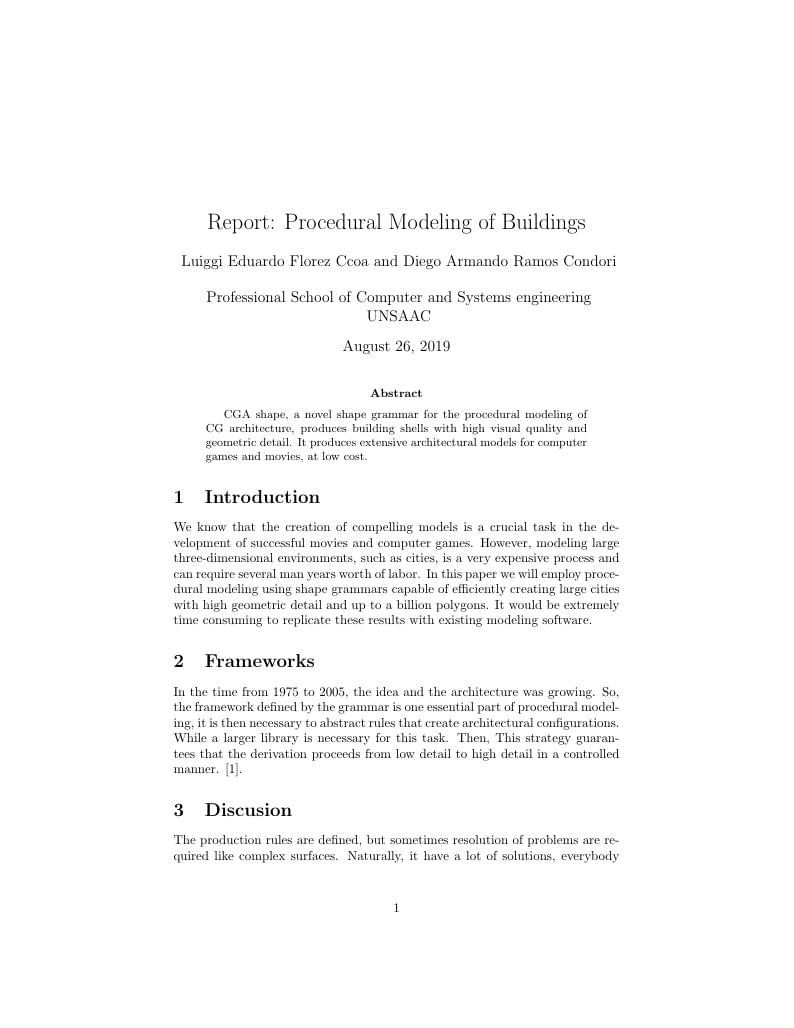
Report on Procedural Modeling of Buildings
Auteur:
FC_RC
Last Updated:
il y a 6 ans
License:
Creative Commons CC BY 4.0
Résumé:
a report for PMB

\begin
Discover why over 20 million people worldwide trust Overleaf with their work.

\begin
Discover why over 20 million people worldwide trust Overleaf with their work.
\documentclass{article}
\usepackage{url}
\usepackage[usenames,dvipsnames]{color}
\usepackage[utf8]{inputenc}
\usepackage{graphicx}%for includegraphics
\title{Report: Procedural Modeling of Buildings}
\author{ Luiggi Eduardo Florez Ccoa and Diego Armando Ramos Condori \\ \\
Professional School of Computer and Systems engineering\\
UNSAAC\\
}
\date{August 26, 2019}
\begin{document}
\maketitle
\begin{abstract}
CGA shape, a novel shape grammar for the procedural modeling of
CG architecture, produces building shells with high visual quality
and geometric detail. It produces extensive architectural models for
computer games and movies, at low cost.
\end{abstract}
\section{Introduction}
We know that the creation of compelling models is a crucial task in the development of successful movies and computer games. However, modeling large three-dimensional environments, such as cities, is a very expensive process and can require several man years worth of labor. In this paper we will employ procedural modeling using shape
grammars capable of efficiently creating large cities with high geometric detail and up to a billion polygons. It would be extremely
time consuming to replicate these results with existing modeling
software.
\section{Frameworks}
In the time from 1975 to 2005, the idea and the architecture was growing. So, the framework defined by the grammar is one essential
part of procedural modeling, it is then necessary to abstract
rules that create architectural configurations. While a larger library is necessary for this task. Then, This strategy guarantees that the derivation proceeds from low detail to high detail in a controlled manner. \cite{SIPSER}.
\section{Discusion}
The production rules are defined, but sometimes resolution of problems are required like complex surfaces.
Naturally, it have a lot of solutions, everybody think different, that becomes in a controversy. One approach to solve this
problem would be to compute the visible facade surfaces directly,
but this would lead to the following complications: (1) the visible
surfaces can be general polygons and it is not necessarily trivial
to compute them.
(2) It is not clear how to write
meaningful shape rules for general polygons.
(3) There is no simple mechanism to assign non-terminal symbols for the facede grammar, because the surfaces are the output of an algorithm, rather than
a production rule. \cite{BibStyles}.
\section{Conclusion}
Finally, this report introduces CGA shape, a novel shape grammar for the procedural modeling of building shells to obtain large scale city models. The paper is the first to address the aspect of volumetric mass modeling of buildings including the design of roofs. These two elements form the major contributions of this paper. Furthermore we introduced several extensions to the split grammar to obtain a complete modeling system. We believe that our work is a powerful adaption of Stiny’s seminal shape grammar idea for computer graphics and we demonstrate the creation of massive city models that have significantly more geometric detail than any existing urban model created in industry or academia.
\bibliographystyle{abbrv}
\bibliography{references}
\end{document}
%%%%%%%%%%%%%%%
This is never printed
%%%%%%%%%%%%%%%